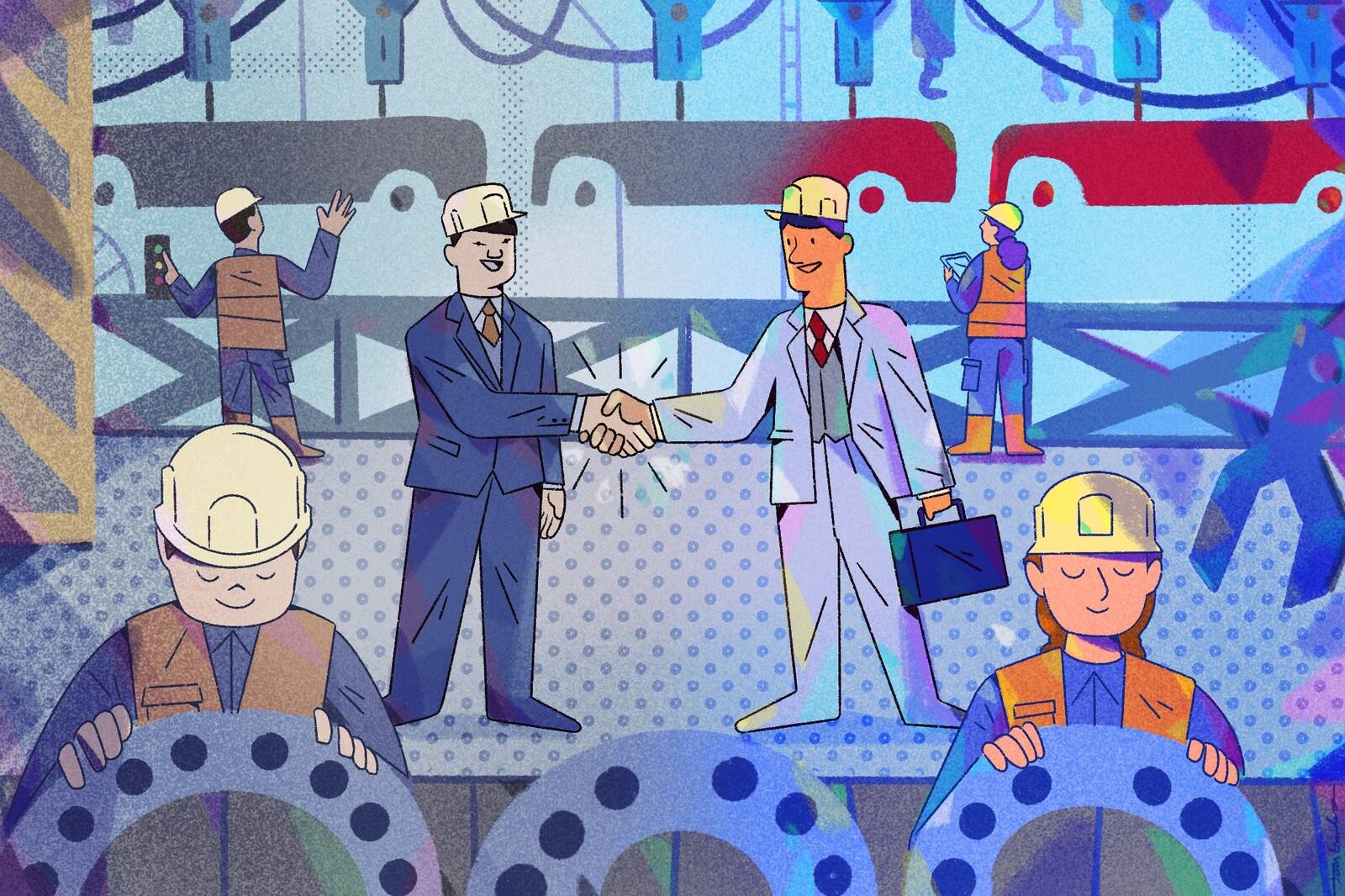Strategy Aug 1, 2025
How Trade Secrets Fuel the International Auto Industry
To expand into China, companies like Toyota, Volkswagen, and BMW were required to work with local manufacturers, who then gained access to crucial knowledge.

Jesús Escudero
In 2001, the Chinese auto industry sold fewer than a million cars. By 2017, it was responsible for more than a third of all the cars produced or sold on earth. Quality improved, too: between 2001 and 2014, malfunction rates in domestic Chinese passenger vehicles fell by 75 percent. How did this growth happen so quickly?
Part of the answer has to do with “knowledge spillovers” from foreign auto firms doing business with domestic partners in China. Shengmao Cao, an assistant professor of strategy at Kellogg, defines these spillovers as “the production know-how, sometimes held secret by a firm, that a partner can observe and assimilate into their own independent operations.”
Knowledge spillovers aren’t necessarily underhanded; they tend to happen naturally whenever companies in the same industry operate in the same place. But they can also be engineered to occur—especially in developing countries, whose governments often compel foreign firms to join forces with their domestic counterparts for the right to do business there.
This quid-pro-quo arrangement—better tech in exchange for access to new markets—usually takes the form of a joint venture between a foreign company and a local one. For example, Volkswagen vehicles are produced and sold in China by SAIC Volkswagen, a joint venture co-owned by German vehicle manufacturer Volkswagen Group and Chinese car manufacturer SAIC Motor.
Cao and his collaborators Jie Bai of Harvard University, Panle Jia Barwick of the University of Wisconsin–Madison, and Shanjun Li of Cornell University wanted to know if the rise in Chinese auto-manufacturing quality could be partly explained by knowledge spillovers from these joint ventures.
“It’s a strategy to climb up the ‘quality ladder’ by learning from industry-leading firms,” Cao explains. “There are a lot of studies on the knowledge-spillover effect of foreign direct investment in general, but there’s very little empirical evidence on this specific joint-venture requirement. It’s a long-standing policy in China’s automobile industry; India, Brazil, and many countries in Southeast Asia also do a version of it.”
And the strategy works, according to the researchers. They analyzed thousands of detailed surveys conducted by J.D. Power & Associates between 2001 and 2014 and found that knowledge spillovers from joint ventures contributed 8.3 percent of the overall quality improvements in Chinese cars during that period.
Cao believes that quantifying these spillover effects can help both sides in a joint venture better understand the quid pro quos—a sensitive matter amid intensifying trade tensions. “The choice for the foreign company is between making a profit [while] potentially nurturing a future competitor, or losing the market altogether,” he says. “It is a high-stakes decision, and a rich question of what the ideal arrangement is.”
Quality on the rise
Historically, researchers have measured the effects of knowledge spillover in terms of “total factor productivity,” a ratio that compresses all of a domestic company’s various economic inputs and outputs together.
“It’s [an] informative measure but can be kind of a black box,” says Cao. “If you produce more output for the same input, that means you’re more productive, but it doesn’t say a lot about how and why.”
To construct more-concrete measures of how knowledge spillovers affected Chinese car-manufacturing quality, the researchers consulted annual customer surveys conducted by J.D. Power and Associates. They analyzed ratings across 19 different performance and quality dimensions (such as fuel economy, braking responsiveness, and interior materials) gathered from nearly 19,000 Chinese car buyers between 2001 and 2014. The surveys covered cars made by Chinese companies like FAW and Brilliance, as well as cars made by joint ventures like FAW-Toyota and BMW-Brilliance (which produce Toyota and BMW vehicles, respectively, for Chinese markets).
“It’s a strategy to climb up the ‘quality ladder’ by learning from industry-leading firms.”
—
Shengmao Cao
By comparing the change in ratings across similar models made by domestic companies versus joint ventures, the researchers could trace evidence of knowledge spillovers. As Cao explains, “a Chinese company that works with a Japanese car company [like FAW did with Toyota] may get better at fuel efficiency. And a Chinese company that works with a German company [like Brilliance did with BMW] may get better at engine performance and safety features. We also look at if these similarities emerge and become stronger over time as the companies work together.”
The data showed that this was indeed the case. In hundreds of pairings, the researchers saw the quality of Chinese-made cars improve along dimensions similar to the foreign models produced by a joint venture. “In other words, we saw that Brilliance cars started looking more like BMW cars in terms of their relative strengths,” says Cao.
The researchers estimated that 8.3 percent of this quality improvement was due to knowledge spillovers from joint ventures.
Strengthening the case for spillovers
Still, the researchers wanted to rule out other explanations beyond knowledge spillover, such as domestic car companies partnering either with companies that are already very similar to them or with companies that target the same kinds of customers.
But while a domestic Chinese auto manufacturer like SAIC may have similarities to Volkswagen in the year 2025, it’s highly unlikely that those overlaps existed when the joint venture was originally formed decades earlier. “Many of these Chinese companies did not have an existing business in the passenger-car industry; they used to produce agricultural machines like tractors and only started making their own cars after accumulating some experience in a joint venture,” Cao says.
Domestic and joint-venture automakers also target very different customers. That’s because Toyotas and BMWs—even when made with Chinese partners—are still much more expensive than fully domestic cars.
What if Chinese automakers were seeing quality improvements simply by licensing patents from their foreign partners? The researchers ruled this out, too: between 2001 and 2009, more than 10,000 patents were licensed or transferred within the Chinese auto industry, but only 27 of them originated from a joint venture.
What’s more, after analyzing job switches noted on the LinkedIn profiles of 53,000 Chinese auto workers, the researchers saw that the manufacturing quality at domestic car companies improved when they had workers who had previously worked at a joint venture. For example, when more workers moved from jobs at SAIC-Volkswagen to Chinese companies like FAW and Brilliance, there appeared to be greater similarity in quality between them. This correlation was especially strong when workers moved from a joint venture to its directly affiliated domestic company (like from SAIC-Volkswagen to SAIC).
The researchers can’t say for sure that these job-switchers directly caused knowledge spillovers, but they consider it a promising potential explanation. “It could be a conduit of knowledge driven by this one-directional worker flow,” says Cao.
A recipe for success?
A near-10 percent bump in manufacturing quality due to knowledge spillover may not sound like much. But this isn’t the only kind of spillover that’s happening in the Chinese auto industry, Cao says. Instead, he thinks of it as a kind of “bonus” that joint ventures add to the baseline amount of industry-wide spillover that normally results from foreign investment.
“Take a hypothetical scenario where BMW is making its own cars in China without a joint venture—spillover would still be happening in other ways, just by [BMW] being there,” Cao says. “What this work shows is that there’s an additional benefit from this direct affiliation in a joint venture.”
For foreign companies, the upside of this quid pro quo is murkier. “Multinational firms sometimes accuse joint-venture policies of just being forced technology transfers,” Cao adds. “It’s actually one of the reasons why Trump initiated the first wave of the trade war between the U.S. and China in 2018.”
Joint ventures aren’t necessarily a foolproof way for industries in developing countries to climb the quality ladder, either. Foreign automakers only enter into Chinese joint ventures because global demand for cars is so huge that “the cost of giving up the Chinese market would be too high,” says Cao. In other markets or industries, the same quid-pro-quo calculus may not make sense. “There’s also the trade disputes that this arrangement might generate,” Cao adds.
Still, Cao’s findings show that under the right circumstances, joint ventures—and the knowledge spillovers they encourage—can be a clear win for host countries. “China’s passenger-vehicle industry went from almost nonexistent 25 years ago to having the highest car sales in the world in 2010,” Cao says. “It looks like a success story.”
John Pavlus is a writer and filmmaker focusing on science, technology, and design topics. He lives in Portland, Oregon.
Bai, Jie, Panle Jia Barwick, Shengmao Cao, and Shanjun Li. 2024. “Quid Pro Quo, Knowledge Spillovers, and Industrial Quality Upgrading: Evidence from the Chinese Auto Industry.” NBER Working Paper No. 27644.



